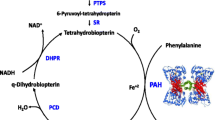Abstract
In a study of 46 adults aged 28–71 years with untreated phenylketonuria (PKU) there were 3 (6.5%) with cataracts. This incidence was similar to that in the Australian population and in a control series of intellectually disabled adults. Only two of the PKU patients with cataracts could be examined by slit-lamp biomicroscopy and in both the findings suggested that the prolonged use of phenothiazines may have played a role. Slit-lamp examination of a further ten untreated PKU patients and 13 PKU adults who had been treated in childhood revealed only small lens opacities (in 40%) of a type found in 72.7% of a control group. The study provides no support for claims that PKU can cause cataracts.
Similar content being viewed by others
Abbreviations
- PKU:
-
phenylketonuria
References
Alexander LJ, Bowerman L, Thomson LR (1985) The prevalence of the ocular side effects of chlorpromazine in the Tuscaloosa Veterans Administration patient population. J Am Optom Assoc 56 (11):872–876
Australian Bureau of Statistics (1979) Sight problems and the use of glasses/contact lenses (persons aged 15 or more), Catalogue No. 4338.0
Crombie AL (1981) Drugs causing eye problems. Presribers' J 21:222–225
Flack AL, Peterson JS, Dolan BJ (1985) Anterior subcapsular cataracts: a review of potential etiologies. Ann Ophthalmol 17:78–80
Fraunfelder FT (1989) Drug-induced ocular side effects and drug interaction. Lea and Febiger, Philadelphia, pp 119–121
Grant WM (1986) Toxicology of the eye. Charles C. Thomas Springfield, pp 225–227
Gualteri CT, Lefler WH, Guimond M, Staye JI (1982) Corneal and lenticular opacities in mentally retarded young adults treated with thioridazine and chlorpromazine. Am J Psychol 139:1178–1182
Hesse RJ (1979) Anterior lens opacities in prolonged phenothiazine therapy, Ann Ophthalmol 11:1212
Hollows F, Moran D (1981) Cataract — the ultraviolet risk factor. Lancet II:1249–1250
Kawashima H, Kawano M, Masaki A, Sato T (1988) Three cases of untreated classical PKU: a report on cataracts and brain calcification. Am J Med Gen 29:89–93
Parks MM, Schwild NF (1963) Bilateral lamellar type cataracts in a case of phenylketonuria. Am J Ophthalmol 56:140–142
Penrose LS (1935) Two cases of phenylpyruric amentia. Lancet I:23–24
Penrose LS (1935) Inheritance of phenylpyruric amentia (phenylketonuria). Lancet II:192–194
Pitt DB (1971) The natural history of untreated phenylketonuria. Med J Aust 1:378–383
Pitt DB, Danks DM (1991) The natural history of untreated phenylketonuria (PKU) over 20 years (in press)
Pitt DB, Roboz P (1965) A survey of 782 cases of mental deficiency. J Ment Defic Res 9:4–23
Siddall JR (1966) Ocular toxic changes associated with chlorpromazine and thioridazine. Can J Ophthalmol 1:190–198
Zwaan J (1983) Eye findings in patients with phenylketonuria. Arch Ophthalmol 101:1236–1237
Author information
Authors and Affiliations
Rights and permissions
About this article
Cite this article
Pitt, D.B., O'Day, J. Phenylketonuria does not cause cataracts. Eur J Pediatr 150, 661–664 (1991). https://doi.org/10.1007/BF02072629
Received:
Accepted:
Issue Date:
DOI: https://doi.org/10.1007/BF02072629




